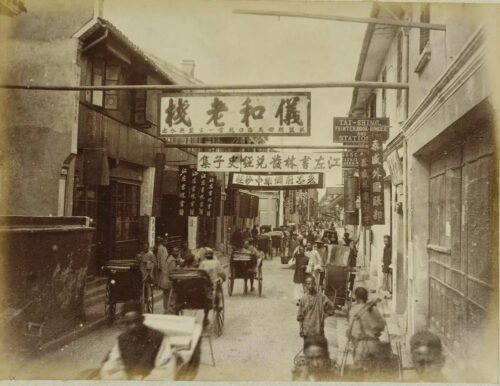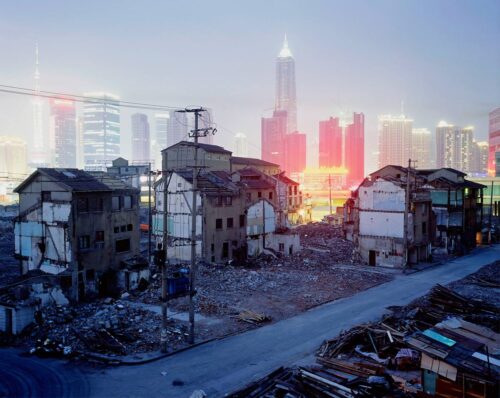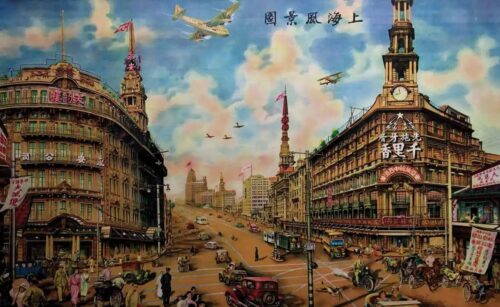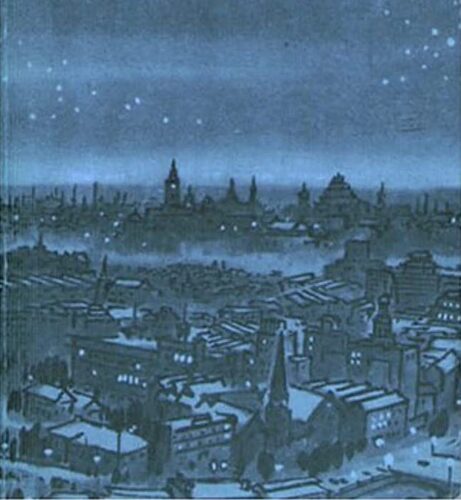Demolition of Laoximen: Shanghai’s best link to its pre-colonial past may soon be gone

Pictured: All of Laoximen as seen from its northeastern corner: Fuxing Road to the left, Fangbang Road to the right (edge of the frame)
All photos by Katya Knyazeva, unless otherwise noted.
As the year draws to a close, government-backed developers are taking yet another bite out of Shanghai’s heritage, proceeding with their broad-stroke destruction of a large historic neighborhood in the former walled city.
Demolition is in full progress in the area east of Laoximen 老西门, once the location of the Old West Gate in the city wall. Everything between Middle Fangbang Road and East Fuxing Road is being obliterated, with the westernmost blocks already emptied and sealed with red plywood. Holes are being made in the walls to make the houses unlivable and prevent residents from returning or squatting. Last weekend, streams of displaced residents could be seen carting their possessions gathered over a lifetime, tied up in bedsheets, away from their former homes.

Word of the demolition’s progress has spread on Chinese social media, which explains the upsurge of photographers in the area, those who want to record the sublime architectural details of a neighborhood that’s been around for 500 years. Residents welcome visitors, saying, “You’d better look now, it’s not going to be here for long.” The local neighborhood committee says that low-rise housing developed by the Huangpu District will replace the shikumen (石库门, vernacular houses) on these ancient winding streets that have housed Shanghainese communities for generations.

This blanket redevelopment is set to sever Shanghai’s last meaningful thread to its pre-colonial history, which stretches back over 1,000 years. Contrary to the widespread belief that Shanghai came into existence 175 years ago — after its designation as a foreign trade port by the Nanjing Treaty — Shanghai was already a thriving town in the 11th century. Some of its oldest temple sites, once located not far from the Yu Garden, go back 1,000 years. By the 13th century, the city was a thriving river port and a cotton production center, and by the mid-16th century, it was protected by a defense wall and a moat. The wall came down and the moat was filled in 1912 to create a traffic ring, but their contours are still imprinted in Zhonghua Road and Renmin Road.

The demolition crews are working west to east: The western section is already emptied out, as workers in orange boiler suits methodically brick up empty residences. Spray-painted symbols identify buildings to be demolished, sealing their fate. A few will survive, forlorn islands that will most likely be turned into high-end restaurants or shopping destinations, more befitting of the image that Shanghai wants to project to the world.

A family packing in a courtyard pauses to explain that it moved months ago but has just returned to collect a few belongings. Of course, not everyone wants to relocate. “I’m not leaving,” says Madam Zhang, who operates a noodle shop in the cramped living room of her home. Like many in the old city, she is a lifelong resident, and doesn’t like the options the government has offered: to move to a new apartment in Jiading District, an hour and a half away, or accept monetary compensation — “much too small,” she sniffs.

The northwest corner of the old city, the nearest to the Huaihai Road commercial district, was the first to get on developers’ radar. In 2005, when demolition was ongoing, a surviving section of the defense wall, measuring 70 meters long, was discovered trapped between the houses. In spite of the outcry from heritage experts and official recommendations to halt the construction and conserve the wall, the Hong Kong developer went ahead with the project. A truncated section of the 450-year-old wall was eventually placed in front of the sales office of the Lanson Place high-rise complex, as an idiosyncratic lawn sculpture.

Laoximen’s old town area is about two square kilometers, though half of it is already modernized. Currently, about 111,000 square meters of the old town is being torn down, which doesn’t seem like a lot, until you understand how much history stands to be lost. Although this neighborhood has lain within the city wall since the 16th century, it remained rural and sparsely inhabited up until the early 20th century. Growing prosperity due to foreign commerce led to increased immigration from other parts of China, and the ensuing building boom transformed Laoximen into a transport hub and a thriving central neighborhood.
Many of the residential complexes here date back to 1912, the year that the old city wall was torn down. Housing that old is nearly impossible to find in Shanghai, with Laoximen being the last neighborhood where this variety is still abundant. The shikumen houses were built on a substantial scale and with durable materials, but overcrowding has somewhat damaged their integrity.

The Laoximen area was always predominantly residential, but schools, workshops, stores, and city services have always been present, located in the same kind of courtyards and lane houses. One such building, inside the decorative brick gate at Lane 19 Muqiao Street, now functions as a local fire station — happily, this building will be spared. A square courtyard at 207 Jinjiafang, richly decorated with detailed carvings of educational and heroic characters, used to be a primary school — Nanhua School — before Liberation.

Further down the street called Jinjiafang (which translates as “Jin Family Arch”), a large house at No. 99 once belonged to a rich family after whom the street is named. The Jins are said to be the inspiration for the popular huju opera Rendezvous in the Nunnery (庵堂相会 Āntáng xiāng huì); the romantic heroine even has the same last name, Jin. The in-house theater at the Jin residence was reportedly the site of the first staging of the opera.


Some buildings in the area break the homogeneity of mass lane house development, and demonstrate surprising architectural features. Two traditional Chinese courtyard houses at Lane 4 Nankongjia Lane are covered with intricate wooden lacework punctuated by lucky charms and Taoist symbols. The same family that built them, named Dong, still inhabits them. This clan became rooted in downtown Shanghai several generations ago, but the impending demolition is about to send it away, to the suburbs.

Even during the century of the concessions (1843–1943), when central areas of Shanghai were ruled by Western administrations, the former walled city remained a Chinese-governed territory. Western styles, however, inspire much of the architecture here. An elegant villa at No. 3 Lane 45 Kongjia Lane is a striking example of late Art Deco. Built in the early 1930s by a prosperous Zhao Fukang 赵福康, it has the boastful name Splendid Mansion (灿庐 Can Lu). A large edifice at 60 Honglangan Street, at the corner of Jinjiafang, used to belong to a certain Wang Shenqing 王慎卿. It is now home to many families, who share access to the roof terrace laid with exclusive Swiss-branded glazed tile with dancing cherubs. According to its residents, this house, too, will remain.

Western influences in the Chinese city go further than the architectural inspiration. A Gothic brick building at 78 Songxue Street is now used as a neighborhood kindergarten. It was originally a Protestant church built by American missionaries in 1899 and renovated in 1933. During the Japanese occupation, this Christian church served as a medical dispensary for the locals trapped in the war-ridden city. Standing at the edge of the threatened area, this repurposed church might be spared the destruction and become a survivor in the war on cultural heritage.
Also see:





